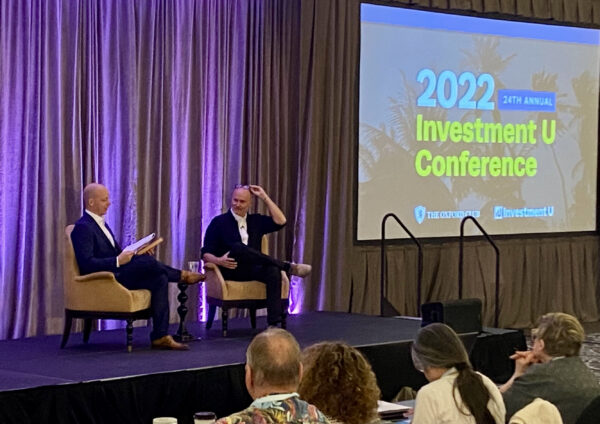No… The Stock Market Is Not a Bubble
- Despite recent investor fears, our current stock market is not a bubble.
- Today, Alexander Green explains how the market differs from previous bubbles and what savvy wealth builders should plan for and expect.
The other day I received a letter from a reader who had grown increasingly alarmed about the market.
“The Dow, with dividends reinvested, has more than quadrupled over the last decade,” he wrote. “I’m afraid that when the bubble bursts I will lose not just my gains but the vast majority of what I invested.”
This is scary to contemplate. But then, so is the idea that a monster is living under your bed.
There is no monster under your bed. And the stock market is not a bubble.
How can we be sure?
Because history shows that financial bubbles are always accompanied by sky-high valuations and unbridled optimism about the future.
Neither is present today.
Consider, for example, the bubble in technology shares 20 years ago. Convinced that “the internet changes everything,” investors paid outlandish prices for stocks with little in sales, zero in profits and no realistic chances of long-term success.
Peak to trough, the leading index of internet-related stocks collapsed 95%.
Or recall the housing bubble of 12 years ago. Home prices rose at a clip never witnessed before.
Many properties created a bidding war among buyers the day they were listed. Folks rushed to take out mortgages they couldn’t afford on real estate they had no business buying.
It was all bound to end badly, as I warned investors during both bubbles.
Now, for comparison purposes, let’s look at today’s stock market.
Over the last century, the Dow has traded at an average of 16 times earnings. Today it sells for 18.5 times earnings.
Is the market more expensive than usual? Yes. A bubble? Absolutely not.
And given that stocks yield not only more than cash but more than 30-year Treasurys, a modest premium is justified.
Note that I said “modest.” The Nasdaq at its peak in March 2000, by contrast, traded at an eye-popping 175 times earnings.
How about rampant optimism?
That is nowhere to be found today. Indeed, there are fewer Americans invested in stocks now than there were before the financial crisis in 2008.
Most are nervous about how long this record economic expansion will continue, worried about the trade war with China and scared about the much-ballyhooed inverted yield curve.
Try finding an investor who is wildly enthusiastic about the outlook for stocks. You won’t.
And, counterintuitive as it sounds, that’s a good thing.
History shows that extreme optimism generally marks a high for stocks, just as extreme pessimism – like the kind we had a decade ago – marks a low.
So be grateful that most investors remain skeptical about the market.
This doesn’t mean, however, that stocks won’t go down – and perhaps substantially.
That risk always exists, no matter how strong the economy, how low the interest rates or how confidently the consumer spends.
If you want to enjoy the higher long-term returns that only equity investors earn, you have to be willing to live with the occasional volatility they also endure.
Some will try to convince you that you can simply jump in for the rallies and out for the corrections.
But that’s just a pipe dream – one that comes with high trading costs, significant capital gains taxes and no shortage of mistimed moves.
The key is to not have more in stocks than you’d be comfortable holding in a significant sell-off or full-fledged bull market.
Because there is a bear market lurking out there somewhere.
And that’s okay. Because right behind it is the next bull.
If you’re aiming for long-term investment success, start by taking a longer-term perspective.
[adzerk-get-ad zone="245143" size="4"]About Alexander Green
Alexander Green is the Chief Investment Strategist of The Oxford Club, the world’s largest financial fellowship. For 16 years, Alex worked as an investment advisor, research analyst and portfolio manager on Wall Street. After developing his extensive knowledge and achieving financial independence, he retired at the age of 43.
Since then, he has been living “the second half of his life.” He runs The Oxford Communiqué, one of the most highly regarded publications in the industry. He also operates three fast-paced trading services: The Momentum Alert, The Insider Alert and Oxford Microcap Trader. In addition, he writes for Liberty Through Wealth, a free daily e-letter focused on financial freedom.
Alex is also the author of four New York Times bestselling books: The Gone Fishin’ Portfolio: Get Wise, Get Wealthy… and Get On With Your Life; The Secret of Shelter Island: Money and What Matters; Beyond Wealth: The Road Map to a Rich Life; and An Embarrassment of Riches: Tapping Into the World’s Greatest Legacy of Wealth.






